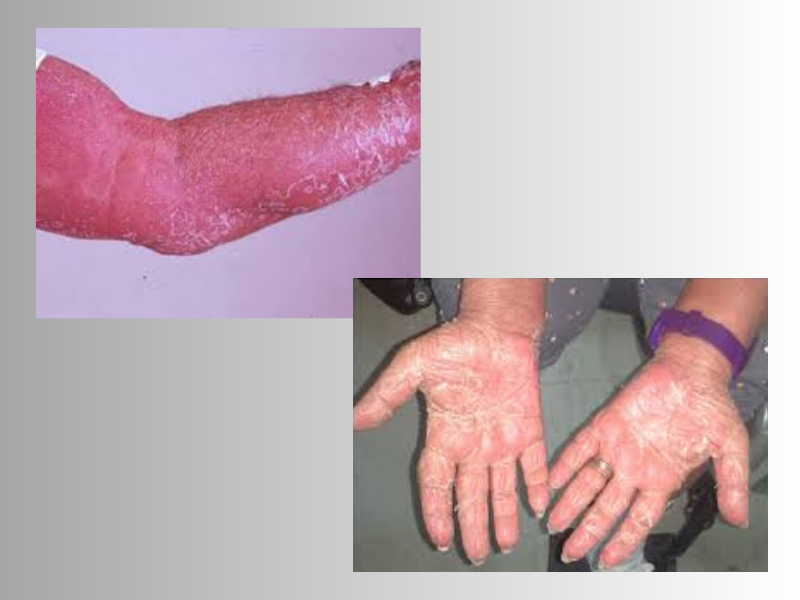Generalized Exfoliative Dermatitis

Generalized exfoliative dermatitis, also known as erythroderma, is a severe skin condition. It is characterized by:
· Scaling and redness of the skin that starts as patches and then spreads.
· Severe inflammation
· Extreme shedding of the top layers of the entire skin surface.
As the skin starts to shed, it causes problems with fluid and protein loss, temperature regulation, and an elevated metabolic rate. The skin’s inability to maintain moisture and regulate temperature can lead to a series of health issues, making it a potentially life-threatening condition.
There is no identifiable cause. However, factors like pre-existing skin conditions, reactions to some medications, and sometimes cancer may contribute to the development.
Causes of Generalized Exfoliative Dermatitis
The exact cause of exfoliative dermatitis may vary. However, certain factors can contribute to its development. This includes:
- Allergic reactions: Allergic reactions to medications such as:
o Antibiotics
o Barbiturates
o Anti-seizure drugs
o NSAID’s
- Existing skin conditions: Existing skin disorders can trigger this condition. These include:
o Eczema
o Psoriasis
o Dermatitis
- Cancer: Certain types of cancer, such as lymphoma, can also cause exfoliative dermatitis.
- Autoimmune disorders: Lupus and dermatomyositis.
- Unknown causes: In approximately 25% of cases, the cause of exfoliative dermatitis remains unknown.
Symptoms of Generalized Exfoliative Dermatitis
The most common signs and symptoms of exfoliative dermatitis include:
- Extreme shedding of the skin, covering most of the body
- Redness and peeling of the skin
- Skin scaling
- Thickened skin
- Itching
- Swollen lymph nodes
- Crusting lesions
- Dehydration due to the skin’s inability to retain moisture
- Swelling in the arms and legs
- Unpleasant odor
- Open sores due to the loss of skin, leading to potential infections
- Fever
- Secondary infections
Complications of Generalized Exfoliative Dermatitis
Possible complications may include:
· Hypothermia due to heat loss
· Red skin causes high-output heart failure.
· Electrolyte imbalances and dehydration due to fluid loss.
· Secondary skin infections cellulitis and impetigo.
· Pneumonia
· Edema due to an elevated metabolic rate and protein loss.
· Brown and/or white skin patches.
Diagnosing Generalized Exfoliative Dermatitis
Diagnosing generalized exfoliative dermatitis involves a thorough process of eliminating potential causes, such as specific medications like barbiturates and penicillin.
Your healthcare provider will conduct a comprehensive physical examination and medical history review to assess for:
· other skin conditions like atopic dermatitis
· certain cancers like lymphoma Additionally
A blood test and a skin biopsy also be performed to confirm the diagnosis.
Erythroderma Treatment
Treatment for exfoliative dermatitis depends on the underlying cause.
1. Severe cases may need hospitalization. The patient is treated with intravenous fluids, antibiotics, and nutritional supplements.
2. Discontinuing of medication that causes this condition.
3. Addressing the underlying skin condition if it is due to another skin problem.
4. Treating the underlying condition that causes this condition.
Managing the symptoms is also crucial in treating the condition. This may involve:
- Wound care to prevent infections.
- Hospitalization to manage dehydration and electrolyte imbalances.
- Using antihistamines and corticosteroids to reduce inflammation.
- Using moisturizers and topical treatments to ease dryness and itching.
Preventing Erythroderma
It’s not entirely possible to prevent this condition. Certain steps can lower the chances of getting or making the condition worse.
1. Avoiding known triggers, such as medications and allergens.
2. Practicing good skincare habits.
3. Avoid prolonged exposure to extreme temperatures or environmental irritants.
4. Maintaining a healthy lifestyle like a balanced diet, regular exercise, and stress management.
5. Seeking prompt medical attention for any signs of skin inflammation or allergic reactions.



